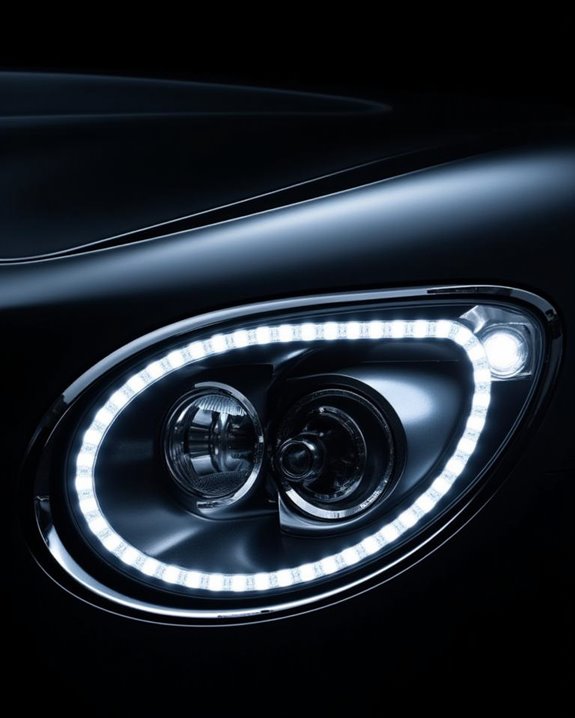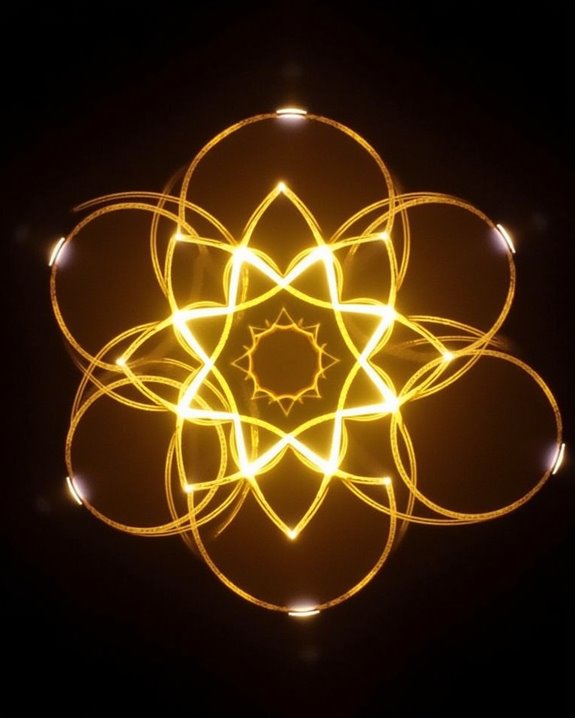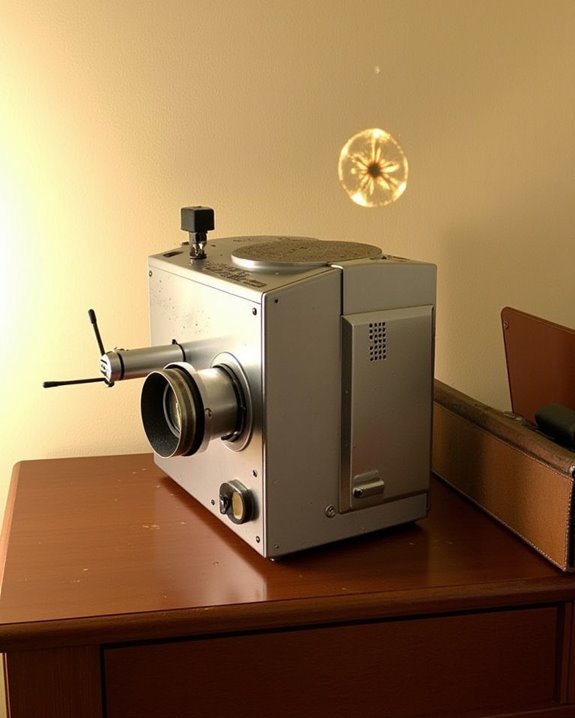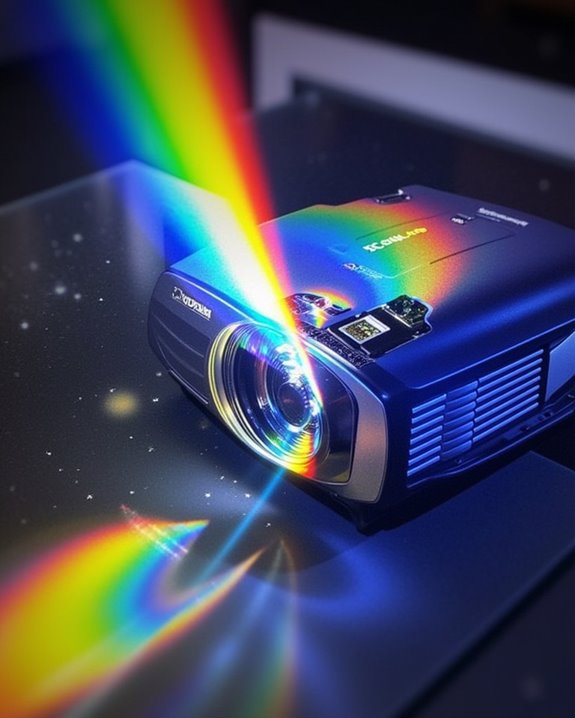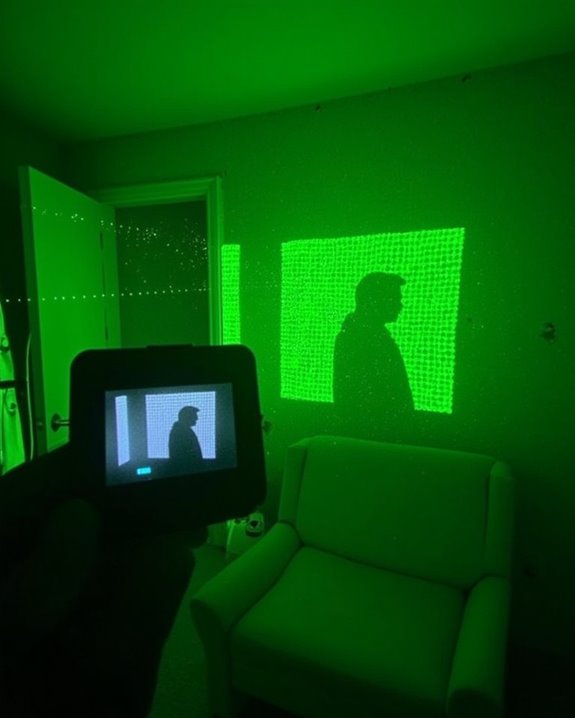You’ve likely noticed those distinctive, circular headlights on modern vehicles that produce an exceptionally clear beam pattern with a sharp cutoff line. These are projector headlights, an advanced lighting technology that represents a significant upgrade from traditional reflector systems. Unlike conventional headlights that scatter light broadly, projector headlights use a precision-engineered combination of light source, reflector bowl, and convex lens to focus illumination exactly where you need it. Their operation involves sophisticated principles of optics that deliver remarkable benefits for nighttime driving safety.
Key Takeaways
- Projector headlights use a light source, reflector bowl, lens, and cutoff shield to create a focused beam pattern.
- They produce a sharply defined beam with a clear cutoff line that reduces glare for oncoming traffic.
- The projector lens captures and concentrates light from the source, creating brighter illumination than traditional reflector headlights.
- Available with halogen, LED, or HID light sources, each offering different brightness levels and color temperatures.
- Their focused beam pattern improves visibility distance and reduces scattered light, enhancing nighttime driving safety.
The Fundamental Structure of Projector Headlights
Although projector headlights may seem complex at first glance, they’re made up of several essential components that work together to create a focused beam of light. At the core is the light source—whether halogen, LED, or HID—which emits illumination that’s captured by the reflector bowl. This reflected light passes through a precision-engineered projector lens that refracts and focuses it onto the road.
The housing, which protects these internal components, comes in various color options to match your vehicle’s aesthetic design. A critical element is the shutter, which creates that distinct cutoff line you’ll notice in projector headlights. The sophisticated lens design and proper alignment of the reflector bowl ensure maximum light output while preventing glare for oncoming traffic, making projector headlights both functional and visually appealing. Modern projector systems often incorporate high contrast ratios to enhance clarity and depth in the beam pattern.
Core Technology Behind Projector Headlight Systems
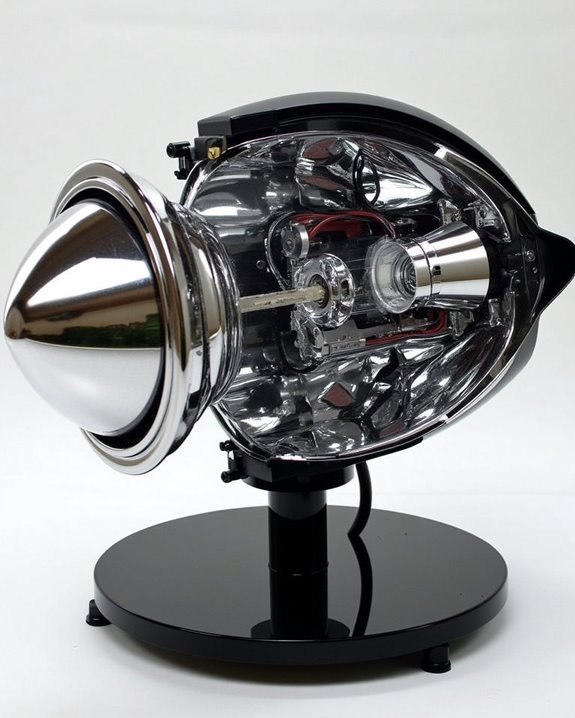
The ingenuity of projector headlight systems lies in their sophisticated technological foundation. At their core, these systems combine a light source, reflector, lens, and cutoff shield to create precisely controlled illumination. You’ll find various light sources available—halogen, LED, or HID—each offering different color temperature ranges and efficiency levels. The reflector collects light from the bulb and directs it toward the convex lens, which focuses the beam into a sharp pattern while minimizing light diffusion.
The cutoff shield plays an essential role in controlling light distribution, creating that distinctive sharp cutoff line that prevents glare for oncoming traffic. This optical precision means you’re getting superior visibility in low-light conditions while ensuring your headlights aren’t blinding other drivers, making projector systems considerably safer than conventional reflector designs. Recent advancements in LED and laser technologies have further enhanced the brightness and efficiency of projector headlights, supporting better performance in various ambient lighting conditions.
Projector vs. Reflector: Understanding the Key Differences

When comparing projector and reflector headlights, you’ll find several fundamental differences that affect performance, safety, and aesthetics. Projector headlights produce a sharply focused beam pattern, creating a distinct cutoff line that reduces glare for oncoming traffic, while reflector headlights distribute light more broadly with less precision.
The color temperature of projector headlights typically runs higher, especially when paired with LED or HID bulbs, giving them that modern bluish-white appearance compared to the yellowish light of traditional halogen reflectors. You’ll pay more for projector technology, but the investment brings superior visibility, longer lifespan, and enhanced styling options. For safety-conscious drivers, projector headlights offer significant advantages through their controlled beam pattern, reducing scattered light while maximizing illumination exactly where you need it. Similar to how high contrast ratios enhance projector image clarity, the precise beam control in projector headlights improves nighttime driving safety.
Performance Benefits of Projector Headlights in Modern Vehicles
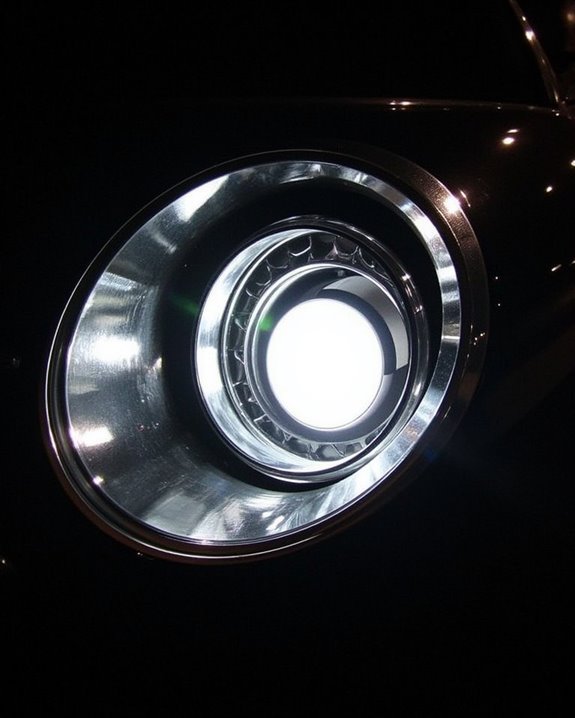
Having understood the differences between projector and reflector headlights, you’ll want to contemplate how projector technology actually performs in real-world driving situations. Projector headlights deliver a precisely focused beam pattern that markedly enhances visibility over long distances, reducing nighttime crashes by up to 19% and pedestrian accidents by 23%. Their higher color temperature provides brighter illumination while minimizing glare for oncoming traffic, creating safer road conditions for everyone.
You’ll appreciate the operational efficiency too, as projector headlights consume less power and require less maintenance, particularly when paired with LED bulbs. The focused light distribution ensures consistent illumination quality, making these systems especially valuable during highway driving when you need reliable long-distance visibility with defined cutoff lines that won’t blind other drivers.
Installation Options for Upgrading to Projector Headlights
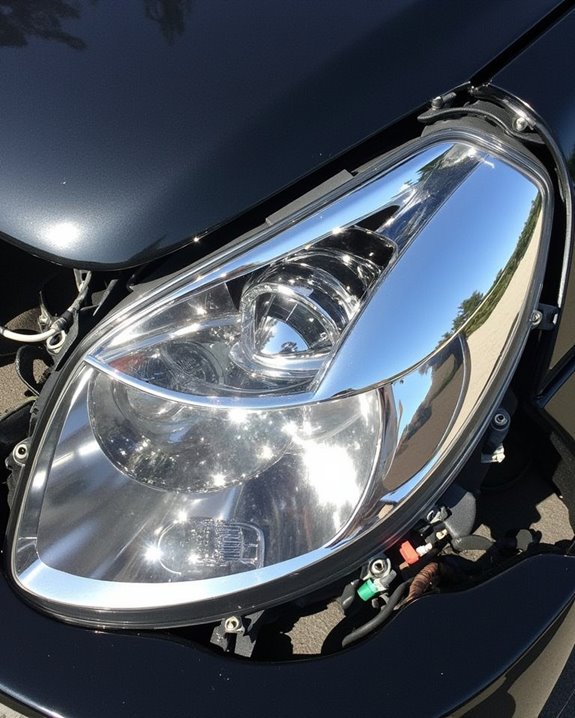
Upgrading your vehicle with projector headlights requires careful preparation and the right tools before you begin the installation process. You’ll need socket wrenches, screwdrivers, and electrical tape, as well as a flat workspace to safely complete the installation. Before starting, disconnect your vehicle’s battery to prevent electrical issues during the upgrade.
Several installation approaches are available, including direct replacement units that fit into OEM mounting points with minimal modification. Custom mounting options range from complete assemblies to retrofit kits that allow you to insert projector lenses into your existing housings. Your wiring options will vary based on headlight features, with LED halos or accent lights typically requiring connection to parking light circuits. For complex installations involving custom wiring or housing modifications, consider professional installation for ideal results.
Maintenance Tips for Optimal Projector Headlight Performance
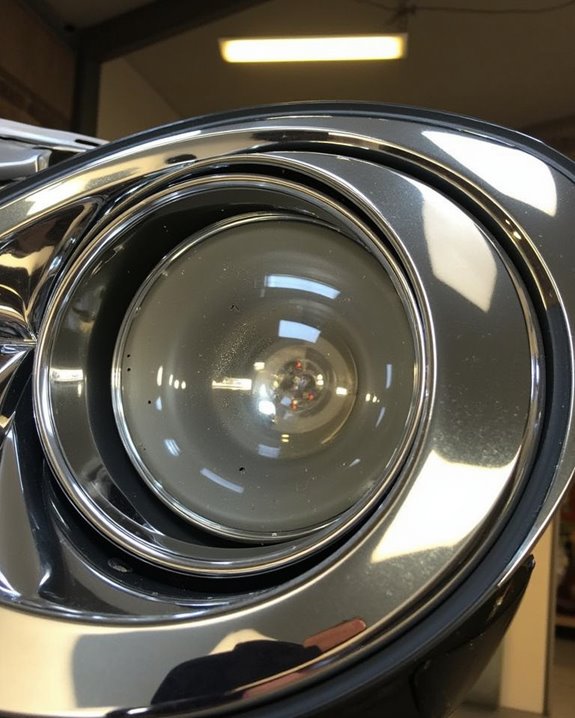
Proper maintenance of your projector headlights isn’t just recommended, it’s essential for maximizing their performance and extending their lifespan. Clean the lenses regularly with a microfiber cloth and mild soap, avoiding harsh chemicals that can damage the surface. While checking your interior lighting systems, make time to inspect headlight bulbs for signs of dimming or flickering, replacing them promptly when needed.
Like consistent tire maintenance protects your vehicle’s handling, regular headlight care prevents moisture buildup inside housings. Check seals for cracks, and address condensation immediately to prevent electrical issues. For persistent problems like fogging or uneven beams, seek professional diagnostics. Professionals can properly align projector lenses to maintain the sharp cutoff pattern that makes these headlights superior to standard reflector designs.
Safety Considerations and Legal Requirements for Projector Headlights
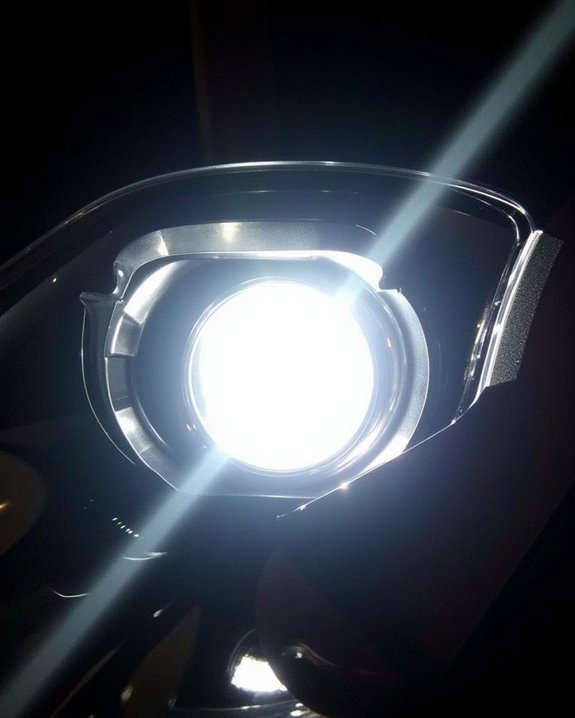
While maintaining your projector headlights keeps them functioning at their best, understanding their safety features and legal requirements is just as important for responsible vehicle ownership. Projector headlights employ precise beam pattern control that focuses light downward, minimizing glare for oncoming traffic while maximizing your visibility during nighttime driving.
For legal compliance, your headlights must meet DOT standards and FMVSS requirements, including appropriate color temperature between 2500 and 6000 Kelvin. When retrofitting with aftermarket parts, verify they’re properly certified and professionally installed to maintain compliance. Remember that regulations may vary regionally, with the U.S. following DOT certification while European markets require E-mark certification. Proper alignment is vital not only for ideal performance but also to prevent dangerous glare that could affect other drivers.
Frequently Asked Questions
Do Projector Headlights Affect Battery Life or Electrical System Performance?
Projector headlights won’t considerably affect your battery life or system performance. They actually create less electrical load than traditional headlights, minimizing battery drain when properly installed and used with your vehicle running.
Can Projector Headlights Cause Snow and Ice Buildup Issues?
Yes, LED projector headlights can cause snow accumulation and ice formation issues because they don’t generate enough heat to melt winter buildup. You’ll likely need to manually clear them more frequently during snowy conditions.
How Do Projector Headlights Perform in Different Driving Terrains?
Ever wondered about terrain versatility? You’ll find projector headlights excel everywhere – offering superior lighting effectiveness in urban settings, enhanced long-distance visibility in rural areas, and consistent performance in challenging weather conditions with visibility enhancement.
Are Projector Headlights More Susceptible to UV Damage Over Time?
No, your projector headlights aren’t more susceptible to UV degradation than standard headlights. All headlight lenses can experience lens discoloration over time, but regular cleaning and protective coatings will help prevent damage.
Can Projector Headlights Be Adjusted for Different Vehicle Heights?
You’d think raising your truck would magically adjust those beams, wouldn’t you? Yes, projector headlights can be adjusted for different vehicle heights through manual screws or automated systems to maintain proper headlight alignment.

